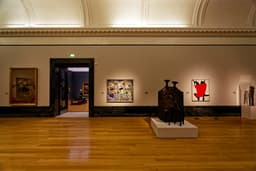
Roger Hilton
@roger-hilton
Roger Hilton: Pioneer of British Abstract Art
Roger Hilton stands as one of Britain's most innovative and pioneering abstract artists, bridging the gap between European modernism and post-war British art. Born in 1911 in London, Hilton dedicated his career to exploring geometric abstraction and constructivism, ultimately becoming a cornerstone figure in establishing abstract art within the United Kingdom's artistic landscape.
Hilton's artistic journey was deeply influenced by his time in Paris during the 1930s, where he encountered the revolutionary ideas of constructivism and abstract experimentation. He studied under prominent modernists and absorbed the continental avant-garde movements that would shape his distinctive visual language. His work evolved from figurative painting into increasingly abstract compositions characterized by bold geometric forms, vibrant colors, and dynamic spatial relationships. Hilton became instrumental in introducing constructivist principles to British audiences, advocating for art freed from representation and devoted to pure formal exploration.
His contributions to art history extended beyond painting into sculpture and drawing, where he consistently pushed boundaries and challenged conventional perspectives. Works such as his geometric abstractions from the 1950s and 1960s demonstrated his masterful command of color theory and compositional balance. Hilton's commitment to modernism remained unwavering throughout his career, despite the challenging post-war art climate in Britain.
Hilton's legacy profoundly influenced subsequent generations of British abstract artists, establishing new possibilities for geometric and constructivist approaches within British art. His fearless experimentation and intellectual rigor helped legitimize abstract art in a nation initially resistant to modernism. Though he passed away in 1975, Roger Hilton's visionary contributions continue inspiring artists and art historians alike, securing his position as a transformative figure in twentieth-century British modernism.